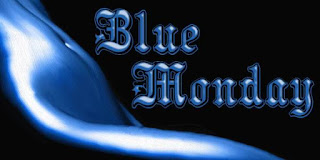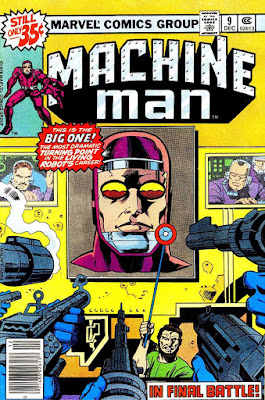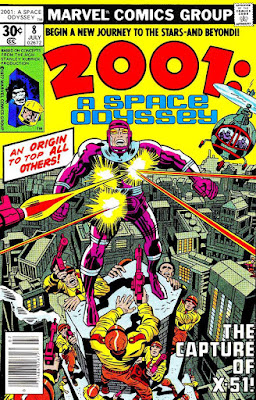Jack Kirby's profound influence on modern pop culture is inarguable. That said - it's started an awful lot of arguments. The biggest being - "Just how much was George Lucas influenced by Jack Kirby in creating Star Wars?"
There are Kirby fans who will swear that Lucas read Kirby's Fourth World books, a light illuminated over his head, and he wrote the script for Star Wars.
There are Lucas fans who say that George never heard of Jack Kirby.
As is generally the case, the truth likely lies between the two.
George Lucas maintains that Star Wars was influenced by Akira Kurosawa's The Hidden Fortress and the old Flash Gordon serials. Happily, we live in the internet age - scripts are available at various stages of development. If you look at the first scripts, Lucas's claimed influences are quite obvious and appear to be absolutely true. All the basic elements in the first draft can be traced back to those two primary influences.
Jump ahead a couple years to the next version, and suddenly we have a lot of new elements and changes to old parts. As the original trilogy unfolds, the parallels become striking.
Kirby's New Gods were connected to a 'mystic life force that surrounds all living things' called The Source. The primary Big Bad was named Darkseid. (That's pronounced "Dark Side", not "Dark Seed" as some Lucas fans argue. For easy reference, whenever you encounter Germanic names with the ei or ie combination, you pronounced the second letter.) The primary hero, Orion, was unknowingly the son of the Big Bad.
In Star Wars, Darth Vader morphed into a cross between Darkseid and classic Kirby villain, Doctor Doom, and is master of the 'Dark Side'. A 'mystic life force surrounding all living things' called The Force was added, as well as the 'holy warriors' who tapped into it as the New Gods do. It took a little longer for Lucas to adopt the Father/Son element of the clash. The role filled by High Father of the New Gods wound up as the wise elder Jedi, Obi Wan Kenobi, and both facilitated the 'baby swap' circumstances of our heroes' childhoods. There are a lot of other little things that are used to reinforce the notion of Kirby influence in Star Wars, from paralleling the Death Star with Apokolips to lining up various characters. But those are the really obvious seeming elements.
For me, it seems obvious that Jack Kirby did indeed influence Star Wars, but it should be remembered that Star Wars was basically nothing but bringing new life to a mix of influences. I see nothing wrong with adding more flavor to the stew. The only wrong is in trying to hide the influence. Unfortunately, it seems typical for the man in the spotlight to try to keep the spotlight on himself. That happened far too often to Jack over the years.
For Kirby, the concern was more one of being able to reliably keep his family comfortably secure. He never seemed as bothered by the lack of attention and respect as those around him. He was always willing to step up and fight for others, to protect those he cared about, but his ego wasn't something i can ever remember seeing him fight for. He knew who he was. He was too busy doing to waste his time trying to make sure everyone else knew.
Privately, he did get upset at times. Ahmet Zappa recalls one of the times when Jack Kirby was dining with Frank Zappa & family*-
“He told my dad stuff like, ‘Darth Vader was Doctor Doom and the Force is the Source’ and that George Lucas ripped him off. Now this you may not know, and I was only a kid, but I remember learning at the dinner table that my dad was asked to write the music for Star Wars; he turned it down, he said he wasn’t interested. That would’ve been really strange, the lives of us Star Wars fans woulda taken a different turn and that whole score woulda sounded like Tatooine Cantina music.”
Every now and then, though, Jack would express himself through his drawings...
Oh, crap. I just realized - We've not been showing proper respect for Star Wars, and now it's owned by...
Eep!
Gotta go
all art by Jack Kirby, some with a bit of embellishment
===
*(Yeah, Kirby & Zappa - we'll get to it)

















































